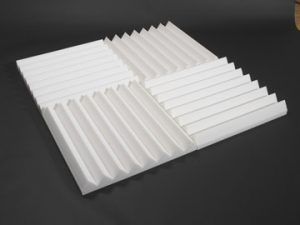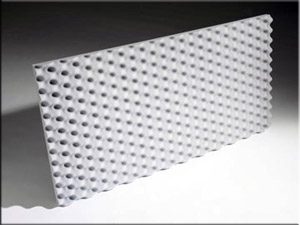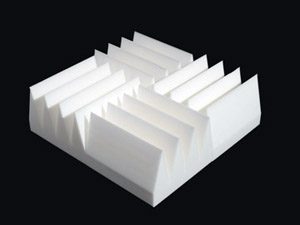Acoustic foams come in many shapes and sizes. They are typically cut into squares or rectangles because its easier to ship the material that way. Rolled forms of foam typically are flat foams with no convolute cut into the face of the material. But flat foam won’t absorb as much sound, because scultped foam has more surface space exposure, meaning it captures more sound waves per square foot than flat foams will. The V-Cuts sound panels are shown here cut into 2’x2′ squares, which each square rotated 90 degrees to create the parquet look.

The grooves that are cut into convoluted foams can vary per supplier, so buyer beware. It’s difficult to illustrate here, but the deeper the cut into the face of the material is, the less material it takes to create a panel, and the less effective the panel is at absorbing echoes. For those surfing the internet looking for foam suppliers, this one aspect is difficult to measure online. Be sure that there is a minimum of a 3/4″ thickness at the base of the convolute to maintain integrity in the panel performance and the sound values you are seeking.
In addition to the V-Cuts, there are egg carton cuts of foam, but again, buyer beware. Because of the way that egg carton cuts of foam are convoluted, the bases and tips of each subsequent panel will not align evenly as you place them on your walls or ceiling to absorb echo. In industrial applications where aesthetics are less important, no big deal. But in an audio setting, or most commercial spaces, the visual impact of the panels is important, and the egg carton style should not be selected. NetWell’s egg carton cut of foam are called FireFlex. 
One final note on foams. Acoustic foam sound panels are typically less expensive than cloth wrapped soundproofing panels, which makes foam more popular for many segments of our client base, but there are two versions of foam. Polyurethane foam is not class A fire rated, and is rarely prescribed anymore,. The alternative, and more popular option, is the class A fire rated melamine foam. If you are a school, church, hospital, restaurant, or other commercial venue, if you opt for a sound panel made of acoustic foam, you will want and need the Melamine Foam. Not all suppliers offer it, be sure to ask for it.
One final note on the selection of an acoustic foam panel system is the depth of the panel. Sound panels made of acoustic foam can be cut to varying thicknesses. The goal is to match the panel depth to the level of low bass frequency noise. The deeper the frequency is, the thicker the acoustic foam sound panel should be. There are MAX Soundblocks on the market that offer extreme levels of sound attenuation for low bass frequency applications. These are often the sound panel of choice for anechoic chamber builds, or drum booths. 
For help on your foam selection, call NetWell’s help desk at 1-800-638-9355 or visit them online at www.controlnoise.com.